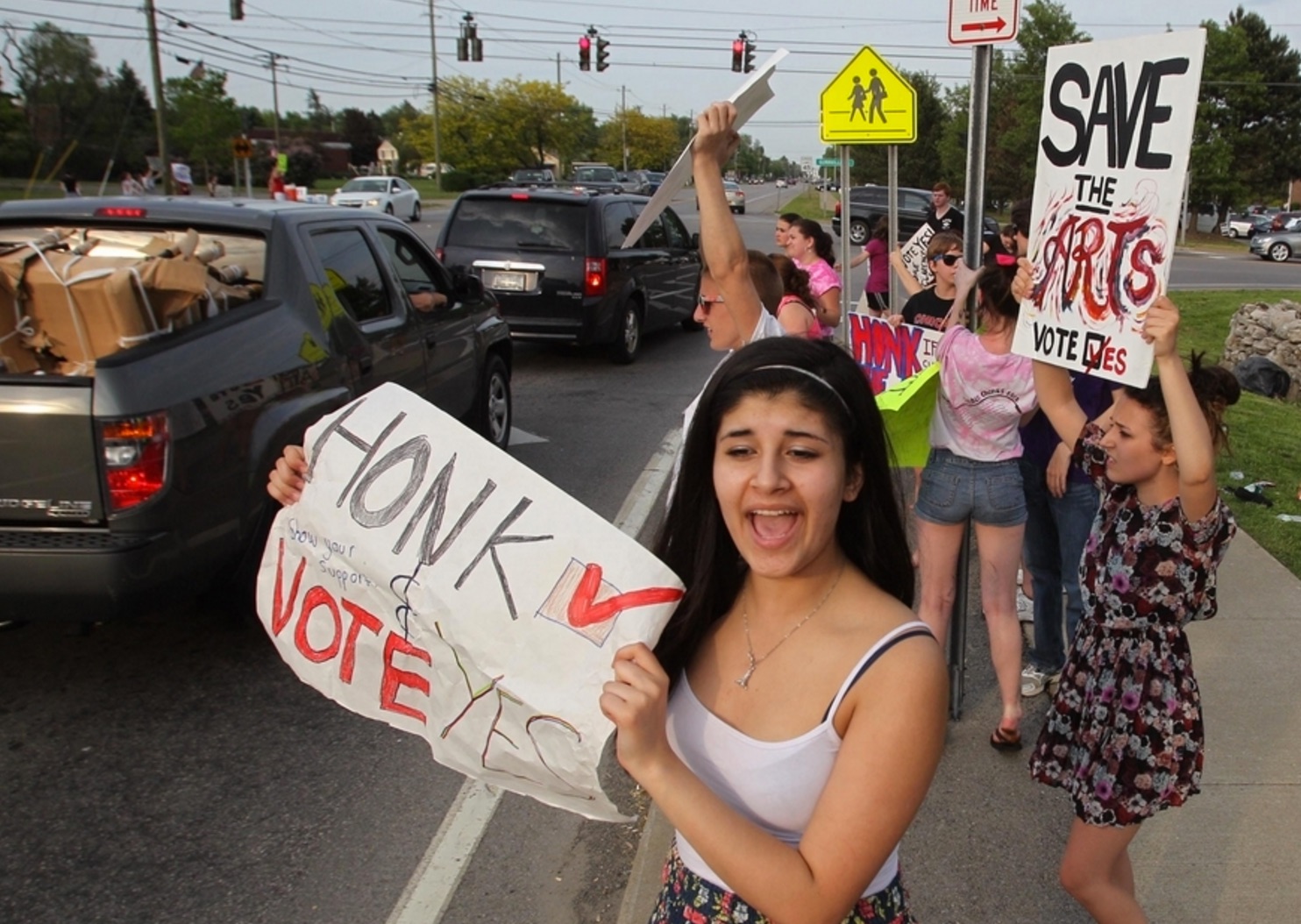Esmonde Demands Magic
And with these passages,
To me, it’s not about bragging rights, or to label schools as “good” or “bad.” It is not to prop up the wrongheaded notion that suburban teachers run laps around their city counterparts.
No, I like the rankings, which are based solely on test scores, for one reason – they confirm what education experts have said for decades: The biggest factor in how well kids do in school is not quality of teachers, variety of programs, class size, access to computers or how often pizza is served in the cafeteria. No, it’s socioeconomics.
Donn Esmonde (who is an Ass™) lays his anti-suburb prejudice bare with his dopey strawman argument. (Where have you ever read anyone write that suburban teachers are better than city teachers, much less that they “run laps around” them? Nowhere, you say? Me, neither.)
The city/suburbs performance divide underlines the grim reality of not just how racially segregated the region is, but – more to the point – how economically segregated it is. The median family income in towns housing the top five schools ranges from $84,155 (Aurora) to $98,914 (Clarence). Median family income in Buffalo? $36,700.
The researchers who wrote the Coleman Report would not be surprised. The landmark 1966 study concluded – with plenty of backup since – that the main factor in school performance is his how much money kids’ parents make and how educated they are. Period.
Yes, successful people with good educations place a high value on education and work hard to make sure their kids get a good one, too. But then, so do many poor people who want their kids to do better and have things that they themselves could never have. It’s a thing called social mobility – the American dream itself – and what do we make of these people who are low on the socioeconomic ladder, but want and demand better? And what of the teachers? Seems as if Esmonde takes a very complicated equation, dumbs it down, and denigrates teachers and poor families as hopelessly stuck.
Of course, a lot of people – including, sadly, test-obsessed state education officials – do not factor socioeconomics into test scores. If they did, they would – and should – grade on a demographic curve. Instead, they see the numbers as “proof” that high-ranking schools have better teachers, superior programs or some magic juju that spurs students. Teachers in tax-controversy Clarence are just the latest to use the rankings to justify $90,000-plus salaries, raises and nearly fully paid health care.
As a veteran columnist and journalist for the sole daily paper in town, one would expect Donn to write truthfully. Had he chosen to do so, or decided perhaps remotely to be accurate, he’d know that the teachers have almost completely stayed out of the tax controversy in Clarence. The teachers’ union has been, alas, too busy determining which members would need to lose their jobs in the wake of the defeat of the crisis budget, rather than engaging in a massive PR blitz to justify anything to anyone.
Simply put, Esmonde’s assertion that Clarence teachers have been making any argument at all in recent weeks is a baldfaced lie, and an insult to them. He also repeats his newfound tea partyism to denigrate the notion that a teacher with 30 – 40 years’ experience are entitled to make a good living with decent benefits. (Teachers in Clarence toil for 20 years before they even hit $50k per year). He is scapegoating people who had nothing whatsoever to do with the cause of the budget crisis in the first place. What a despicable and detestable liar.
I don’t want to diminish the good work that teachers do. But, for the most part, test scores are not about how good a particular school’s teachers are. Instead, they reflect the background of the kids they teach.
You just did, asshole. You should say these things to your teacher wife, to her face.
Doubt it? Then imagine this: Take all the kids from, say, Buffalo’s Burgard High and send them to Williamsville East for a year. Take the Williamsville East kids and send them to Burgard for a year. You don’t have to be a school superintendent to guess what would happen: Test scores at Burgard would skyrocket, test scores at Williamsville would nosedive.
It would not be because the Burgard teachers suddenly upped their game, or because the Williamsville teachers lost their touch. It would be about who is sitting at the desks.
That’s why regionalism guru David Rusk has long pushed for fairer housing policies, to ease the overload of poor families in inner cities. Everything from mandated mixed-income housing in the suburbs, to sprawl-reversing business tax breaks, fuels the economic integration that would level the field in classrooms across the region.
Hypothetical. Theory presented as fact. Ignorance of the fact that (a) anyone can pay a cheap tuition and send their kids to any public district in NYS at any time; and (b) there was (may still be) a program whereby kids were bused from Buffalo into Amherst schools. I can’t find the name of the program, or whether it’s still going on, but there it is.
Sprawl – the bogeyman for everyone who willfully ignores that North and South Buffalo are little more than, respectively, Tonawanda and West Seneca that happen to be accidentally within city boundaries. Sprawl – the word people invoke to effectively demand a Maoist long march of families from the evil suburbs to the joyful city – just carry what you can and stay on the path, lest the comrade guard beat you with a bamboo shaft!
“Housing policy is school policy,” wrote Rusk in a still-relevant 2001 report on Erie County schools. Inner-city classrooms “cannot overcome the many problems and minimal home support many children bring to school … With 80 percent poor children, you aren’t going to ‘fix’ the Buffalo schools.”
There is no reason for suburban teachers to check the school rankings and feel smug. Just as there is no reason city teachers – of whom my wife is one, although not in a classroom – to feel defensive. But given what is at stake, I think there is every reason to understand what these test scores are really about.
Good to see Esmonde finally owning up to the source of his anti-suburb / anti-suburban school animus. But this entire column is based on a false premise of crowing teachers. Quite the contrary, I haven’t seen any crowing about much of any of it, anywhere.
Some places do. There is a growing national movement to economically integrate schools. Studies show that poorer kids do better when surrounded by Hollister-wearing classmates. The upscale kids, in return, get the diversity benefit – hugely touted as a selling point by colleges – of meeting kids from a different background. It works all around.
Check the school rankings, if you insist. But if you want to put any weight behind the numbers, I think you first have to level the playing field.
Esmonde doesn’t detail what the hell he’s talking about. Which is it – redistributing poor kids into rich schools and vice-versa, or a unified Erie County school district? Since more kids in wealthier towns tend to come from families that value education, we should better integrate them with kids who come from homes with no such value in schooling, and what will happen, precisely? The kids who come from homes where no one gives a shit will somehow magically excel?
If you present the problem as being one of fundamental socioeconomic divergence – whereby one population is rich, white, and cares about schools – and the other is poor, black, and doesn’t care about schools – what specific solution does Esmonde provide here, except to bus poor kids to rich districts and vice-versa? If the socioeconomic problem is so stark, shouldn’t we be talking about much, much more than a long bus ride? Aren’t there systemic, societal problems that go deeper than “sprawl” and ‘teachers are greedy’?
Socioeconomic factors matter, but the worst school district has the 2nd best high school. How can that be possible?
Well, it’s possible because socioeconomics are just part of a larger, more complicated equation – not the sine qua non of school or student success, as Esmonde suggests. That equation is made up by home makeup, parental education (which is the most significant factor in predicting a child’s educational achievement), parental values and expectations, but also good teachers and quality programs. Programs that kids who come from poor or middle-class homes need more than the richer kids whose families can afford private replacements.
A correspondent tells me that Amherst’s Windermere elementary school is a Title 1 poverty district, and 40% of kids there are ESL or in special education. Socioeconomics without parental involvement, however, aren’t a predictor of success, and that parental involvement is the bigger factor. By no means should anyone reduce or discard the importance that an inspiring teacher can have on a kid’s education and lifelong success. Without parental support, involvement, and valuing education, even the best teacher will fail.
Buffalo itself is segregated into families that care and families that don’t. Does Esmonde recommend kids who did poorly in school or have a track record of being absent more than present come in to City Honors to maintain the equality he demands from suburban districts? No, of course not – City Honors is the school for Buffalo’s elite and Esmonde would never dare to upset them or their suburb-in-the-city existence. He is one of them. Imagine if someone had suggested they simply arbitrarily mixed in some kids from Burgard at City Honors, as Esmonde recommends? Why not?
The key isn’t money – the key is whether the family values education as a path to lifetime success. Because what we’re talking about is social mobility and improving upon one’s family history, and to that end, Esmonde gives up on the poor from uneducated households and assigns to them a lifetime of failure and misery that could only be alleviated if you move them in with rich white people. What a cop-out. What a capitulation.
My God, Donn Esmonde is an Ass.™

 Did you speak with your anti-tax friends how the school tax rate – even with the 9.8% hike would have been significantly less than it was in 2003? 2005? The rate would have risen to $15.52/$1000. In 2007 it was $15.86. In 2003 it was $16.85. Did you know that in the last 4 years, Clarence has lost $13 million in state and federal funding? No, you didn’t. If you did, you ignored it.
Did you speak with your anti-tax friends how the school tax rate – even with the 9.8% hike would have been significantly less than it was in 2003? 2005? The rate would have risen to $15.52/$1000. In 2007 it was $15.86. In 2003 it was $16.85. Did you know that in the last 4 years, Clarence has lost $13 million in state and federal funding? No, you didn’t. If you did, you ignored it. 















